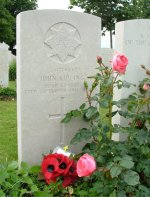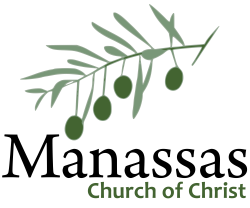 Headstone Two in Row D of Plot Seven at St. Mary's Advanced Dressing Station Cemetery bore, for eighty years, the inscription: "A Lieutenant of the Great War, Known Unto God." The wording, repeated on so many crosses, row on row, was that of the founding member of Britain's Imperial War Graves Commission, Rudyard Kipling. The young lieutenant beneath Headstone Two in the aforementioned cemetery, was John Kipling, killed at the battle of Loos on September 27, 1915, just weeks after being accepted into the Irish Guards.* Recently, using forensics unavailable at the time his father was desperately trying to ascertain the fate of his only son, John Kipling was positively identified.
Headstone Two in Row D of Plot Seven at St. Mary's Advanced Dressing Station Cemetery bore, for eighty years, the inscription: "A Lieutenant of the Great War, Known Unto God." The wording, repeated on so many crosses, row on row, was that of the founding member of Britain's Imperial War Graves Commission, Rudyard Kipling. The young lieutenant beneath Headstone Two in the aforementioned cemetery, was John Kipling, killed at the battle of Loos on September 27, 1915, just weeks after being accepted into the Irish Guards.* Recently, using forensics unavailable at the time his father was desperately trying to ascertain the fate of his only son, John Kipling was positively identified. John Kipling was only sixteen when Princip lobbed his bomb into Franz Ferdinand's touring car. Pressed by his father to volunteer, he was rejected because of poor eyesight. The elder Kipling, best-known and best loved writer in the English Language at the time was an unabashed (some would say jingoistic) supporter of Empire, and so procured a commission for his son from the high command anyway. No one quite knows what John thought about all this. His last words to his mother before leaving for the front were "Send my love to Dad-O." In a few weeks he was dead.
The battle of Loos was the first in which chemical warfare and tanks were used - both by the British. It was where John Kipling went missing, until a few years ago. Kipling's friend, H. Rider Haggard (author of King Solomon's Mines, and She) interviewed as many witnesses as he could find. He discovered that John was last seen with a bandage around his head; his face partially blown away. Lieutenant Kipling was crying from the pain and trying to make his way to the rear of the lines to get assistance. Haggard kept this information to himself.
Kipling tried to deal with the loss, guilt and betrayal he felt, in various ways. Some were productive, like founding and heading the Imperial War Graves Commission. Some were vengeful. He went on a letter writing campaign to leaders in the U.S., like Teddy Roosevelt, encouraging them to pressure President Wilson to send troops to "kill the Huns". His writing turned dark - blaming himself, the Germans, Britain and fate (God?) in turn for his son's death. Mostly he wanted to know what happened. He died, after 20 years of searching, without any real information about the fate of his son.
In a late story, The Gardener, Kipling tells of an unmarried woman, Helen Turrell, raising her brother's orphaned son, Michael. They are as close as mother and son, and at home he calls her "Mummy", but in public, out of respect for the dead, she insists on being called "aunt". Michael is called up to fight in the Great War and is killed. Kipling describes how in an instant, a single shell takes Michael's life and buries him. Against all hope he is found, identified and interred in France. Helen goes to find his grave and is met with the surreal view of acre after acre of identical crosses. She weeps, despairing of ever finding his grave. A man comes to help; he appears to be the Gardner. She tells him she is looking for "Lieutenant Michael Turrell - my nephew". "Come with me", he says, "and I will show you where your son lies." The story then references the verse from John 20.15 where Mary Magdalene can not find the body of Christ, and meets Him in the garden, supposing, at first, that he is the gardener.
"Known unto God." Kipling wrote that. His son's marker proclaimed it. Ultimately, it was all he had, and it was enough. The story The Gardener accesses the comfort of Mary in Gethsemane. Kipling goes back to the Word, back to God's only son, back to the empty tomb to reach the resolution that only Grace provides.
There is another verse this story references. When Jesus is asked by Jairus to heal his daughter he is told she is a little girl. At twelve years of age, nearly old enough to be betrothed, she would have been called a youth, not a tot. But when Jesus raises her form the dead he says "Little Girl Arise" (Note that here, as in his reply to Mary in John 20.15 we have Jesus' words in the original Aramaic). He sees her as a little girl - the way Jairus does - just as the gardener knows Helen is looking for her son, not her nephew.
God knows, God knows everything. That is enough.
*Detail of Kipling's death taken from "Young Men and War", by Christopher Hitchens in Vanity Fair, 1997.




